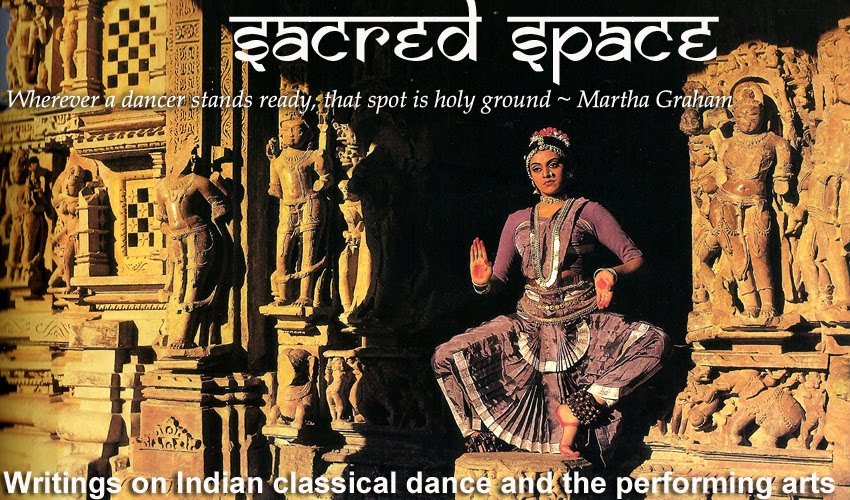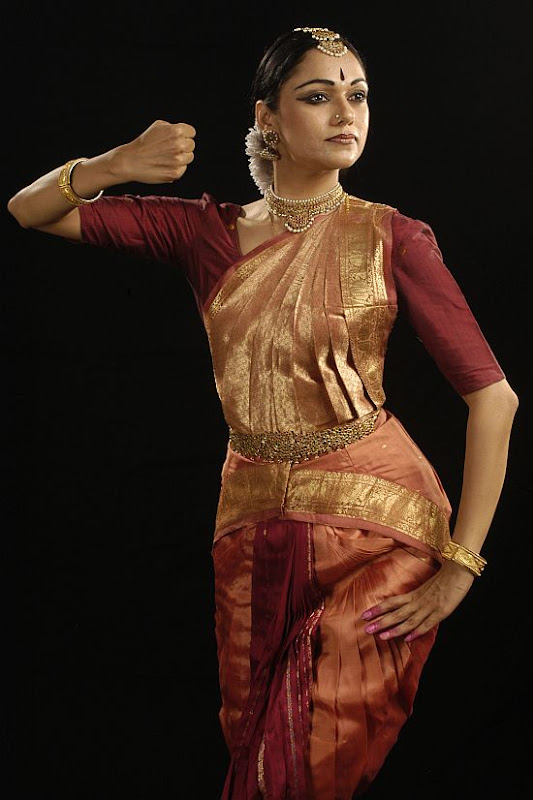
From the rakkodi on the crown of her head, to the nupura adorning her feet, the classical dancer is literally bejewelled from head to toe. Jewellery is an essential part of the dance costume. It adds sparkle to a dancer’s appearance and enhances the visual effect and aesthetic appeal of her dance, invoking rasa in the observer.
The use of costume and jewellery is called aharya abhinaya, one of the four types of abhinaya described in the Natya Shastra, Bharata Muni’s classical treatise on the performing arts. It mentions the four types of jewellery or ornaments to be worn by a dancer, which “if used properly and with understanding add beauty to the body.” It then illustrates in detail the specific ornaments to be worn by male and female performers. While these number to 16 for men, there are over 38 for women, including six for the hair and head, eight for the ear, six for the neck, at least two garlands of jewels and pearls for the breast, eight for the hands and fingers, five for the hips, and three for the ankles and feet!
Bedecked and bejewelled in this way, it is difficult to imagine how a dancer can attempt even the simplest dance movement. However, after this detailed description, the ancient text does concede that too much jewellery can restrict movement and defeat its very purpose: “Too many ornaments are not to be used lest the artists feel tired or hindered in free movements. Weighed down with heavy ornaments one cannot move much and one is likely to feel exhausted. So decoration not done properly is no decoration at all.”
It is no surprise that many dancers today prefer a minimal use of jewellery. Real jewellery made of pure gold and precious stones is heavy and cumbersome – and not to mention, exceedingly expensive. Among some dancers today there seems to be a trend towards reducing the ‘bejewelled from head-to-toe’ look to one of minimal elegance which responds to the dictate that less is certainly more.
“I don’t wear any jewellery when I’m performing contemporary dance,” explains renowned danseuse and choreographer, Aditi Mangaldas. “But I like to wear jewellery when I’m doing traditional Kathak. Traditional Kathak jewellery is made of gold, uncut diamonds, emeralds and rubies. Most of the jewellery I use is Jadau jewellery which I find in Ahmedabad, Hyderabad and Lucknow. When I wear a beautiful piece of jewellery, it gives me a sense of grandeur even if it’s just a small thing. I think jewellery adds embellishment to a dancer: the tikka frames the face, and bangles bring attention to the wrists because we use a lot of mudras and wrist movements. I like to keep the look minimal but classy. I don’t like heavy, overbearing jewellery. For me, jewellery has to be as light as possible but it also has to look real. I wear only a tikka, earrings and slightly thick bangles on each wrist. I don’t wear long necklaces anymore. I don’t like wearing rings or anything on my feet.”
For leading Bharatanatyam dancer Rama Vaidyanathan, the sheer resplendence of South Indian temple jewellery is a good reason not to wear too much of it. “I love temple jewellery because its vibrant colours are very striking,” she reveals. “It’s the ideal jewellery to wear with Kanchivaram saris because it matches so well. But because it’s so striking, I don’t want to clutter myself. The less I wear, the more it stands out.” Rama gives much thought and importance to her jewellery: “I choose my jewellery to match the costume I’m wearing but also according to the theme of the performance,” she explains. “For example, one of my recent productions, Akhilam Madhuram, is based on Krishna and the symbolism of Mathura and Vrindavan, and explores the theme of bhakti. I used Rudraksha beads which are significant for their healing powers and matched it with a Tanjore pendant. I like old, traditional pieces and I often come up with my own designs. My inspiration comes from temple sculptures, old Tanjore paintings and Ravi Varma paintings.”
The vibrant colours of the contrasting deep red rubies and brilliant green emeralds of temple-style jewellery are indeed visually striking. The intricate, often symmetrical designs are inspired by temple sculptures as well as motifs found in nature like flowers, lotuses, leaves and creepers, fruits like mangoes, and animals like peacocks and swans. The traditional jewellery was made of pure gold and embedded with uncut diamonds, rubies, emeralds and pearls. Today replicas are made in silver and covered in gold leaf, with semi-precious stones.
This jewellery worn by Bharata Natyam and Kuchipudi dancers has a very long tradition dating back over 5000 years to the Nayaka period. This jewellery of gold and precious stones was traditionally made for temple idols by master craftsmen whose workshops were located within the precincts of temples. Nagercoil, a temple town in Tamil Nadu, is famous for its temple jewellery which would be used to adorn the temple deities during important festivals. It was also worn by the resident temple dancers, a tradition which has continued onto the stage today.
In contrast to the opulent temple jewellery of South India, the silver jewellery used by Odissi dancers is elegantly understated. Cuttack in the state of Orissa is famous for its silver filigree work. Orissan tribal jewellery is also made of silver. The silver belt worn by Odissi dancers as well as the tahia or crown, are unique to this dance style.
“Odissi jewellery has a distinct style,” explains celebrated Odissi dancer Sujata Mohapatra. “It adds beauty and elegance to the dance. The tahia (crown) is unique to this dance style and resembles a temple spire. The bengapatia, (silver belt) is also unique to Odissi. The maharis who had danced in the temples had worn many necklaces around the neck and several chains around the waist. The leading gurus had come together and decided on the aesthetics of the Odissi costume and jewellery. It should not be too heavy. The beauty of the body has to be seen.”
Inspiration for the Odissi costume came from temple sculptures as well as the Abhinaya Chandrika, written in the 15th century by Maheswara Mohapatra. This text mentions the costume, ornaments and make-up to be used for Odissi and describes a silver belt to be worn around the waist. In her biography of Guru Kelucharan Mohapatra, The Making of a Guru, Odissi dancer Ileana Citaristi recounts when the bengapatia was first introduced: A broken and discoloured bengapatia was found in an old box of jewellery belonging to the mother of a Brahmin from Puri. Guru Kelucharan Mohapatra painstakingly rethreaded the belt and meticulously cleaned it with tamarind. It was first worn by legendary dancer Sanjukta Panigrahi at the All-India Dance Seminar held in Hyderabad in 1963. Now it has become a hallmark of the Odissi costume.
For practical and aesthetic reasons, there seems to be a trend among dancers towards reducing the ‘covered from head-to-toe’ look to one of minimal elegance which responds to the dictate that less is certainly more. Dancers agree that jewellery should embellish the dancer but not hamper the dance. Afterall, as Bharata Muni cautions in the Natya Shastra: “decoration not done properly is no decoration at all.”
A modified version of this article was published in the June 2011 issue of On Stage magazine.







The temple jewelry dazzles me. There's a lot of precious stones like diamond, sapphire, emerald. I also love the ruby earrings worn by the girl.
ReplyDeleteI usually get my accessories from online jewelry stores, and this kind of jewelry always dazzles me. Thanks for sharing your lovely article.
ReplyDeleteIt is known to the world that people in India are fond of using and wearing jewelries both for aesthetic and therapeutic purposes. I love those jewelries. In the present time, people are also into using sterling silver jewelry because of its cheaper value and design.
ReplyDeleteYou have managed & compiled really unique & real information. It’s really very helpful for us. You've made some great points and it’s written really well.
ReplyDeleteVery impressed by this blog..It give unique info..especially Dance jewellery..all the best to the team..I heartily wish that this blog continues.
ReplyDelete